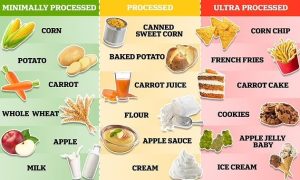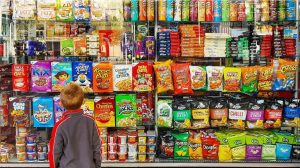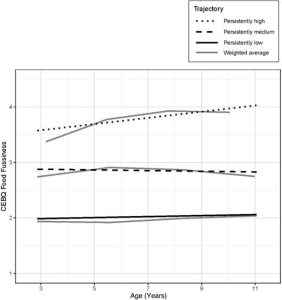1 Chapter 1: Hijacking the Cheat Code: How Ultra-Processed Foods (UPFs) and their Makers Exploit Children’s Eating Habits
By Akimi Ashizawa
It’s 6 o’clock in the morning. Timmy’s mom has to get up, and get ready for work. She also has to wake Timmy up so that he can eat breakfast and go to kindergarten. Breakfast today, as it has been for the past week, is an Eggo Waffle. It’s fast, easy, and she knows Timmy will like it. Timmy eats his Eggo happily, and goes to school. At lunch, he buys a slice of pizza from the school cafeteria, another one of his favorites. After his mom comes home from work, she immediately gets started on dinner. Dinner tonight is chicken green bean casserole. Timmy’s mom needs to stretch the 2 cans of cream of chicken soup she has to feed the family of 5. Plus, she barely has time to eat and go to her next job. Timmy isn’t totally happy with the casserole because it has green beans, so he eats around them and just has the chicken and gravy. Timmy’s mom really wants Timmy to eat his green beans, but she knows it isn’t worth the fight. She doesn’t have the time or the energy.
Ultra-Processed Foods (UPFs): An Introduction
Definition of UPFs

Essentially all of the foods that Timmy ate are considered ultra-processed. Ultra-processed food (UPFs) is a group of food that must undergo multiple intensive industrialized processes to be created, which include adding high amounts of salt, fat, sweeteners, preservatives, and artificial flavors and colors. Undergoing these transformations mean UPFs are not recognizable from their original ingredients and cannot be recreated exactly in a home kitchen. UPFs are also often very cheap, convenient, and extremely palatable, to the point of being addictive (Montiero et al., 2019).
UPFs Make Up Most of Children’s Diets
According to a study conducted in 2018, two-thirds – or 67% – of the calories consumed by children and adolescents came from UPFs (Nuñez, 2021). This data is especially concerning because children’s dietary habits inform their lifelong eating habits as well as their continuous development and growth. The present mainstream conversation surrounding UPF consumption frames it as an individual choice. And in the case of children, society is quick to blame parents for “allowing” their children to eat UPFs, deeming them irresponsible for doing so.
However, portraying childhood UPF consumption in this manner does not capture childhood UPF consumption in its entirety. It excludes key information about UPF’s ability to exploit the body’s biological mechanisms and how this exploitation is more likely to impact certain demographic groups because of currently upheld social institutions. The hijacking of biological development sets up children to develop a strong preference for UPFs, especially amongst lower-income families. This phenomenon increases these children’s risk of malnutrition, chronic health issues, and a dysregulated relationship with food.
How UPFs Hijack Childhood Biological Development
A Taste for UPFs Starts in Pregnancy
Research that specifically evaluates the effects of mothers’ UPF consumption on children’s sense of taste is very new, and animal studies currently comprise the majority of the published research in this arena. Nevertheless, these recent findings demonstrate a correlational relationship between UPF consumption and development of neonatal taste preferences. The most notable example is a 2020 Cornell study published in Nature Magazine. It concluded that rat offspring from mothers who were fed a high-fat diet consumed more sugar and high fat and possessed genes attuned to tasting for these elements (Choo et al., 2020). In essence, the study finds that mothers consuming UPFs during pregnancy causes children to develop taste buds that are fine-tuned to sense the way UPFs taste. And because of that honing, children physiologically develop a preference for UPFs.
Additionally, a 2015 study in non-human primates fed pregnant non-human primates a diet mimicking the nutritional density of UPFs. The study measured the offspring’s food intake and effects on the offspring’s neurological reward system. The results were that offspring produced less dopamine, the reward system chemical responsible for feelings of pleasure and happiness. The researchers hypothesized that this altered signaling led to the offspring’s propensity for increased consumption of palatable food high in fat and sugar (Rivera et al., 2015). Essentially, because of the dopamine deficiency, offspring were constantly searching for food to give them a dopamine boost. Because non-human primates are closely related to humans, the likelihood that this event occurs in human babies is high.
Together, these two studies demonstrate that UPFs begin altering babies’ taste perception and reward system even before they are born. Additionally, these 2 biological systems work in tandem, and modifying them both leads to large synergistic consequences. There is the immediate effect of UPFs tasting good and the lingering, follow-up reward of dopamine and feeling good. However, these two effects together create a double whammy of pleasurable sensations, encoding a powerful reward loop in babies that gives them a taste for UPFs before they even begin eating UPFs themselves.
UPFs Impact Toddlers’ Neurological Response to Food
Programming this reward loop in babies primes them for UPF flavor conditioning during the toddler stage. Flavor conditioning is a natural development of when toddlers’ brains learn a faster, more efficient way to anticipate a food’s taste and the good feelings that result from it. Through enough time and exposure, flavor conditioning leads to toddlers completely associating a particular taste with good feelings, and it is particularly good at creating this association when it comes to foods high in sugar and fat (Picard, 2015). In the context of this paper, UPF flavor conditioning is the result of what happens when these babies’ encoded reward loops are fully realized. The taste of UPFs and dopamine become inextricably intertwined, and UPFs have significantly hijacked the body’s reward system. In children, this reward system hijacking has a significant long-term consequence – it makes the increased likelihood of preferring, craving, and eating UPFs at the expense of minimally processed food a persistent, lifelong dietary habit (Calcaterra et al., 2023).
In summary, UPFs predetermining babies’ and toddlers’ taste preferences and reward system leaves them vulnerable to a higher propensity for chronically eating a diet mainly consisting of UPFs. Not only that, but exposure to UPFs at a very young age produces dietary habits and behaviors that are analogous to addiction. By considering the way UPFs as exploiting childhood development of biological and behavioral systems, it becomes clear that children eating a largely UPF-based diet is not solely based on individual choice. In fact, it is quite the opposite, as these children were not given the chance to ever develop a preference for anything but UPFs.
The Social Factors at Play in UPF Consumption
Accessibility of natural and minimally processed food is not created equal. UPFs are much cheaper than minimally processed food, which is partially due to government subsidies. For example, corn and soybeans are 2 out of the 7 US crops which are most heavily subsidized by the US government. These subsidies pay for the 5% of corn and 50% of soybeans that are converted into high fructose corn syrup and soybean oil – 2 products that are common ingredients in many UPFs (Siegel et al., 2016).
Additionally, 2 key characteristics of UPFs are that they are often convenient and shelf stable. This convenience means that UPFs are often ready-made for consumption, such as by just adding water to instant noodles and microwaving a frozen meal. UPFs’ long shelf life means that they do not spoil quickly, typically due to preservatives and other additives.

Moreover, UPF marketing is specifically tailored to target children. This includes making specific mascots for products, like Tony the Tiger for Frosted Flakes; collaborating with the entertainment industry to put recognizable characters, like SpongeBob, on Mac & Cheese; including toys in cereal boxes and meals; putting all these products in children’s eyelines in grocery stores. And all of these tactics work. According to the American Psychological Association (APA), “Food and beverage advertising targeted at children influences their product preferences, requests, and diet” (APA, 2010). These persuasive techniques encourage and enable UPF addiction, making it socially acceptable.
UPFs Particularly Sway Low-Income Children
Therefore, it is not surprising that those who are dependent on UPFs as their main food source are typically lower-income households (Vignola et al., 2021). This is because lower-income households have less time, money, and resources to prepare meals. Often, low-income working parents are working within their constraints, leading these families to consume UPFs, even if they know UPFs could be detrimental to their health as well as their children’s. As these children develop flavor preferences and reward systems that are biased towards UPFs, parents from low-income families continue to buy these products due to convenience and a desire to not waste money and resources (Daniel, 2015). This lack of choice means that the likelihood of children from these households developing a strong propensity for eating UPFs is high.
The Implications: Connections to Other Topics in Nutrition and Health
High UPF Consumption Forms Picky Eaters

These biological and social frameworks are important to consider because it points to the bigger issue of the way UPFs shape children’s relationship with food, especially in terms of picky eating. Often, picky eaters are more likely to be sensitive to a food’s visual appearance, texture, smell, and recognizability (Picard, 2015). UPF manufacturers engineer food to be appealing visually, texturally, and olfactorily, as well as easily recognizable to get consumers to continuously crave and buy their products. Because of this engineering, picky eaters may be more likely to accept UPFs in comparison with their minimally processed counterparts. If picky eaters choose UPFs for long periods of time, it could become very difficult to introduce minimally processed food into their diet.
In the mainstream conversation of picky eating, it is often suggested that children will naturally grow out of these behaviors. However, this is not true. In a 2020 study published by the American Academy of Pediatrics, results show that picky eating behavior starts at 4 years old and remains constant until at least 4 years after being identified (Fernandez et al., 2020). While not enough research has been done to examine the trend of childhood picky eating into adulthood, it is likely that picky eating will still continue into adolescence or even be a lifelong habit. Even if these children later learn to accept new foods beyond UPFs, the flavor conditioning that they learn as toddlers still remains intact. Therefore, these children could still be at high risk of relapsing into these old patterns of eating, especially in times of stress and need for comfort.
Relations to Food Sovereignty
All these factors beg the question of whether childhood UPF consumption and picky eating violate food sovereignty – the ability to choose what you want to eat. If these children were biologically manipulated to crave UPFs, were fed high-UPF diets since birth because of accessibility and socioeconomic issues, and were won over by manufacturers and marketing who may not have their best interests at heart, was there ever really a choice of not learning to love UPFs? And if so, doesn’t that mean these children’s autonomy over their health and well-being was taken from them?
High UPF Consumption Hurts Picky Eaters’ Long-Term Health
This selective way of eating can be detrimental to the child’s health. Often, the discussion of UPF’s impact on health revolves around childhood obesity. Childhood obesity is important to discuss because it often leads to development of chronic diseases, such as diabetes, high blood pressure, stroke, and cancer (Centers for Disease Control and Prevention, 2022). While this health risk is important to discuss, it overshadows the bigger picture of UPFs in relation to malnutrition. According to the World Health Organization (WHO), “malnutrition refers to deficiencies, excesses, or imbalances in a person’s intake of energy and/or nutrients” (WHO, 2024). UPFs lead to an increase in consumption of sugar and total fat, especially saturated fat. However, it also leads to a decrease in consumption of fiber, protein, and other essential vitamins and minerals (Martini et al., 2021). So, regardless of the child’s weight status, if the majority of their diet consists of UPFs, they will still most likely not be receiving the adequate nutrients that they need. When UPFs are considered through the larger lens of childhood malnutrition as opposed to just obesity, the scope of impact that UPFs have on children is much larger.
Conclusion
In conclusion, the development of children’s favoritism for UPFs is dependent on physiological responses as well as social and environmental factors. Understanding the hijacking mechanisms behind this favoritism is important because it illustrates that childhood UPF consumption is not solely based on choice. There are other circumstances involved, such as neurological reward systems, socioeconomic status, and marketing, which have been informing these children’s food choices since their conception. Painting a broader picture of how childhood UPF consumption is happening realistically will help us to better address it, allowing these children to reclaim their food sovereignty and consequently, agency over their health.
References
American Psychological Association. (2010, November 17). The impact of food advertising on childhood obesity. Https://Www.apa.org. https://www.apa.org/topics/obesity/food-advertising-children
Calcaterra, V., Cena, H., Rossi, V., Santero, S., Bianchi, A., & Zuccotti, G. (2023). Ultra-Processed Food, Reward System and Childhood Obesity. Children, 10(5). http://dx.doi.org/10.3390/children10050804
CDC. (2022, July 15). Causes and Consequences of Childhood Obesity. Centers for Disease Control and Prevention. https://www.cdc.gov/obesity/basics/consequences.html
Choo, E., Wong, L., Chau, P., Bushnell, J., & Dando, R. (2020). Offspring of obese mice display enhanced intake and sensitivity for palatable stimuli, with altered expression of taste signaling elements. Scientific Reports, 10(1). https://doi.org/10.1038/s41598-020-68216-7
Daniel, C. (2016). Economic constraints on taste formation and the true cost of healthy eating. Social Science & Medicine, 148, 34–41. https://doi.org/10.1016/j.socscimed.2015.11.025
Fernandez, C., McCaffery, H., Miller, A. L., Kaciroti, N., Lumeng, J. C., & Pesch, M. H. (2020). Children Don’t Grow Out of Picky Eating [Graph]. American Academy of Pediatrics. https://doi.org/10.1542/peds.2019-2018
Fernandez, C., McCaffery, H., Miller, A. L., Kaciroti, N., Lumeng, J. C., & Pesch, M. H. (2020). Trajectories of Picky Eating in Low-Income US Children. American Academy of Pediatrics, 145(6). https://doi.org/10.1542/peds.2019-2018
Food marketing to children [Photograph]. (n.d.). Consumer Voice. https://consumer-voice.org/resources/food-marketing-tactics-on-childrens-health/
Levels of food processing [Diagram]. (n.d.). The Daily Mail. https://www.dailymail.co.uk/health/article-12452913/Ultra-processed-food-study-warns-dangers-MailOnlines-guide.html
Martini, D., Godos, J., Bonaccio, M., Vitaglione, P., & Grosso, G. (2021). Ultra-Processed Foods and Nutritional Dietary Profile: A Meta-Analysis of Nationally Representative Samples. Nutrients, 13(10), 3390. https://doi.org/10.3390/nu13103390
Monteiro, C. A., Cannon, G., Levy, R. B., Moubarac, J.-C., Louzada, M. L., Rauber, F., Khandpur, N., Cediel, G., Neri, D., Martinez-Steele, E., Baraldi, L. G., & Jaime, P. C. (2019). Ultra-processed foods: what they are and how to identify them. Public Health Nutrition, 22(5), 936–941. https://doi.org/10.1017/s1368980018003762
Nuñez, X. (2021, August 11). If You Think Kids Are Eating Mostly Junk Food, A New Study Finds You’re Right. NPR. https://www.npr.org/2021/08/11/1026816658/study-us-kids-diet-ultraprocessed-junk-food
Picard, D. (2015). Food rejections in children: Cognitive and social/environmental factors involved in food neophobia and picky/fussy eating behavior. Appetite., 96(C), 347–357. https://doi.org/info:doi/
Rivera, H. M., Kievit, P., Kirigiti, M. A., Bauman, L. A., Baquero, K., Blundell, P., Dean, T. A., Valleau, J. C., Takahashi, D. L., Frazee, T., Douville, L., Majer, J., Smith, M. S., Grove, K. L., & Sullivan, E. L. (2015). Maternal high-fat diet and obesity impact palatable food intake and dopamine signaling in nonhuman primate offspring. Obesity, 23(11), 2157–2164. https://doi.org/10.1002/oby.21306
Siegel, K. R., Bullard, K. M., Imperatore, G., Kahn, H. S., Stein, A. D., Ali, M. K., & Narayan, K. M. (2016). Association of Higher Consumption of Foods Derived From Subsidized Commodities With Adverse Cardiometabolic Risk Among US Adults. JAMA Internal Medicine, 176(8), 1124–1124. https://doi.org/10.1001/jamainternmed.2016.2410
Vignola, E. F., Aydin Nazmi, & Freudenberg, N. (2021). What Makes Ultra-Processed Food Appealing? A critical scan and conceptual model. World Nutrition, 12(4), 136–175. https://doi.org/10.26596/wn.202112483-135
World Health Organization. (2024, March 1). Malnutrition. Who.int. https://www.who.int/news-room/questions-and-answers/item/malnutrition
Media Attributions
- Figure 1_Levels of Food Processing
- Figure 2_Marketing Food to Children
- Figure 3_Children Don’t Grow Out of Picky Eating
